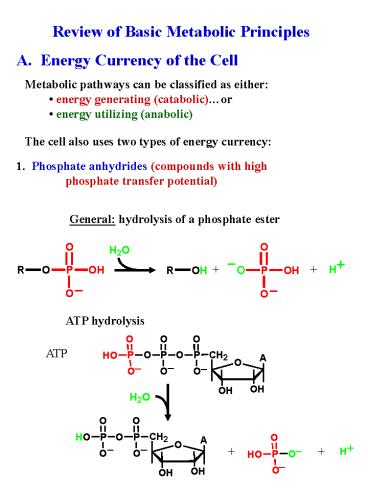Review of Basic Metabolic Principles - PowerPoint PPT Presentation
1 / 13
Title:
Review of Basic Metabolic Principles
Description:
Review of Basic Metabolic Principles. A. Energy Currency of the Cell ... FAD/FADH2. Example = lactate dehydrogenase. Synthetase or synthase: catalyzes the joining of ... – PowerPoint PPT presentation
Number of Views:332
Avg rating:3.0/5.0
Title: Review of Basic Metabolic Principles
1
Review of Basic Metabolic Principles
A. Energy Currency of the Cell
- Metabolic pathways can be classified as either
- energy generating (catabolic)or
- energy utilizing (anabolic)
The cell also uses two types of energy currency
1. Phosphate anhydrides (compounds with high
phosphate transfer potential)
General hydrolysis of a phosphate ester
ATP hydrolysis
ATP
2
Free Energies of hydrolysis of some
phosphorylated compounds
- ATP is the most commonly used compound with
- high phosphate transfer potential
- phosphoenolpyruvate creatine phosphate
- have enough energy to synthesize ATP
- ATP can be used to synthesize glucose 6-
- phosphate similar compounds
- GTP is sometimes used in place of ATP
3
ATP is called the energy currency of the cell
Catabolism
Anabolism
O2
Work
Heat
ATP
Foods
Biosynthesis
CO2 H2O
Energy
- Definitions
- catabolism is the production of energy from
- food
- anabolism is the utilization of energy to
provide - heat, do work, or drive biosynthetic reactions
- Reducing equivalents (compounds with high
- electron transfer potential)
Foods ? NADH and FADH2 ? ATP for Biosynthesis
- The reducing equivalents in the foods we eat
- are transferred to NADH and FADH2
- NADH and FADH2 transfer their electrons to
- the electron transport chain which..
- uses the energy in those electrons to synthesize
- ATP
4
- Based on what you already know, you might predict
- that
- catabolic pathways produce NADH, FADH2,
- ATP
- anabolic pathways utilize ATP, NADH, FADH2
- However, thats not quite true. In reality
- catabolic pathways produce NADH, FADH2,
- ATP
- anabolic pathways utilize ATP, NADPH, FADH2
B. Coenzymes
1. Definition
- Coenzymes are small molecular weight
- compounds that are
- necessary for the catalytic activity of
- one or more enzymes
- present in very small amounts compared
- to the substrates of the enzyme
- used over over in a catalytic manner
- most coenzymes exist free in solution
- some coenzymes are bound to proteins
- prosthetic groups
5
2. Coenzymes carry some biologically important
chemical group in an activated (high
energy) form so that it can be used in
biosynthetic reactions
Example coenzyme A (carries acyl groups)
CoASH
H20
acetic acid
acetyl CoA
?G? -7.5 kcal/mole
CoASH
H20
acyl CoA
carboxylic acid
6
3. Coenzymes are sometimes derived from vitamins
Some activated carriers in metabolism
7
C. What Does a Metabolic Pathway Look Like?
- many reversible reactions
- a few irreversible reactions that drive the
- pathway
- the irreversible reactions are important!
A
B
C
D
E
F
E1
E2
E3
E4
E5
D. Control of Metabolism
1. Controls Which Operate at a Cellular Level
- regulation is by inhibitors activators in cell
a. Which metabolites usually regulate pathways?
- The precursor of a pathway usually
- stimulates the pathway
A
B
C
D
E
ii. The end product of a pathway usually inhibits
the pathway
-
A
B
C
D
E
8
iii. The end product of a competing
pathway often stimulates the other pathway
A
B
C
D
E
G
H
I
- Energy utilizing producing pathways
- are often regulated on the basis of
- ATP supply in the cell
- Catabolic pathways are inhibited by
- ATP and/or stimulated by ADP or AMP
- Anabolic pathways are stimulated by
- ATP and/or inhibited by ADP or AMP
b. Where are pathways regulated?
i. At or near a branch point
D
A
B
C
9
ii. At 1st committed (irreversible) step
A
B
C
D
E
2. Controls that operate at whole body level
- sites of regulation similar, but mechanisms
different
- Peptide hormones (glucagon, epinephrine,
- insulin)
- act via second messenger (eg, cAMP)
- result in phosphorylation or dephosphoryl-
- ation
- alter enzyme activity
- are fast acting
b. Steroid hormones (cortisol)
- travel to nucleus bind to DNA
- affect amount of enzyme made
- are slower acting
10
E. Glossary of Enzyme Names
Kinase catalyzes the phosphorylation of
some metabolite, usually with ATP as the donor
Example glucokinase or hexokinase
ATP glucose ? ADP glucose 6-phosphate
Phosphatase catalyzes the hydrolytic removal of
a phosphate group (also called dephosphorylation)
Example glucose 6-phosphatase
glucose 6-phosphate H2O ? glucose Pi
Phosphorylase catalyzes the phosphorolytic cleava
ge of a bond (phosphate is the attacking
nucleophile)
Example glycogen phosphorylase
11
Hydrolase catalyzes the hydrolytic cleavage
of some bond (water is the attacking nucleophile)
Often subclassified according to bond
cleaved Esterase hydrolyzes ester
bond Peptidase hydrolyzes peptide
bond Phospholipase hydrolyses phospholipids
Dehydrogenase catalyses oxidation-reduction react
ions by the transfer of hydrogens (electrons).
Generally use NAD/NADH or FAD/FADH2.
Example lactate dehydrogenase
Synthetase or synthase catalyzes the joining
of two molecules to create a larger molecule
Example citrate synthase
oxaloacetate acetylCoA H2O ? citrate CoASH
(4 carbons) (2 carbons) (6 carbons)
12
Carboxylase catalyzes the addition of CO2 to a
molecule. Uses biotin as a coenzyme
Example pyruvate carboxylase
OAA ADP Pi
pyruvate CO2 ATP H2O
Transferase catalyzes the transfer of a group
from one molecule to another. Subclassified accor
ding to group transferred
Transaminase transfers amino groups. Uses
pyridoxal phosphate as a coenzyme.
Example aspartate transaminase (AST)
?-ketoglutarate
Aspartate
Glutamate
Oxaloacetate
13
Transaldolase transfers aldehyde groups.
Uses thiamine pyrophosphate as a coenzyme
aldehyde
Transketolase transfers ketone groups.
Uses thiamine pyrophosphate as a coenzyme
ketone
Acyltransferase transfers acyl (carboxylic
acid) groups. Uses coenzyme A as a coenzyme
acyl (carboxylic acid)
Methyltransferase transfers methyl groups.
Decarboxylase removes carboxyl groups as CO2
Isomerase converts from one isomer to another































